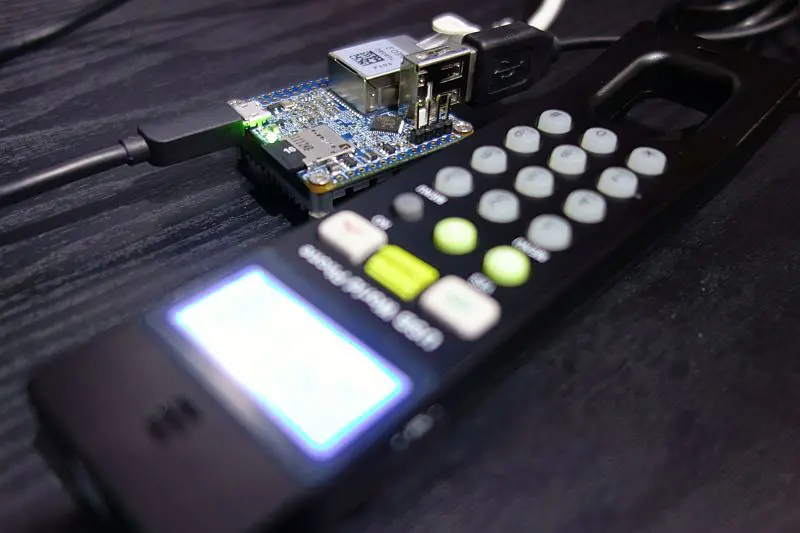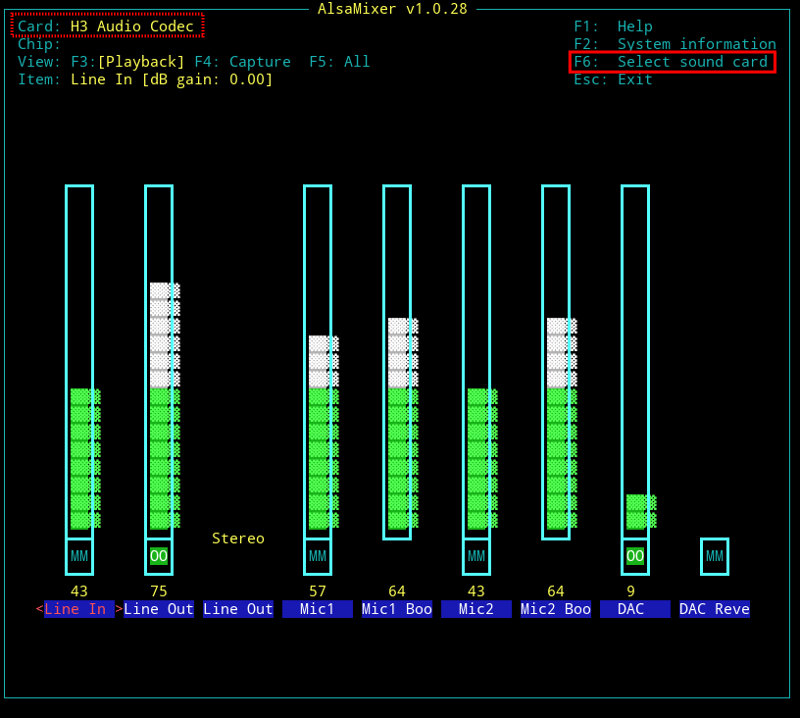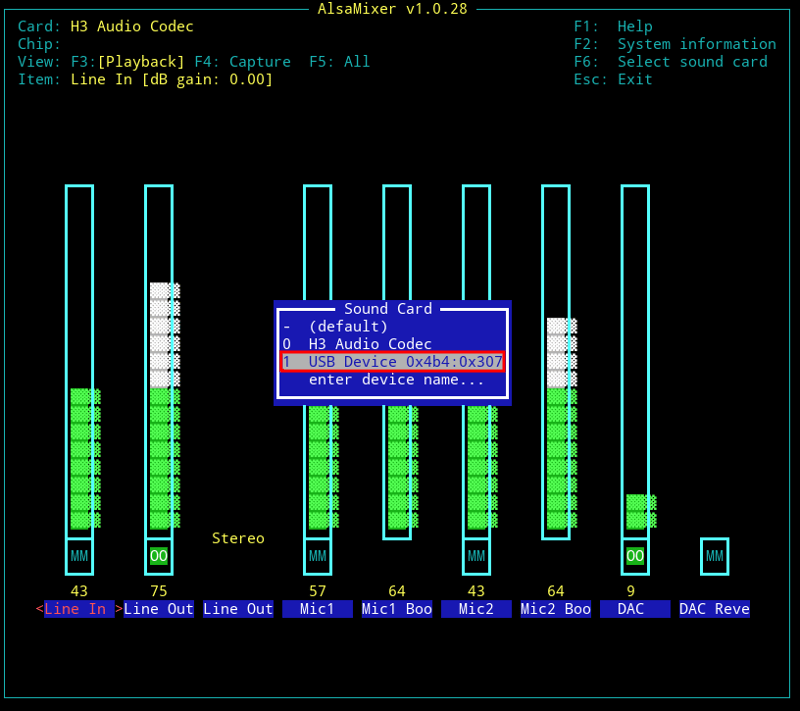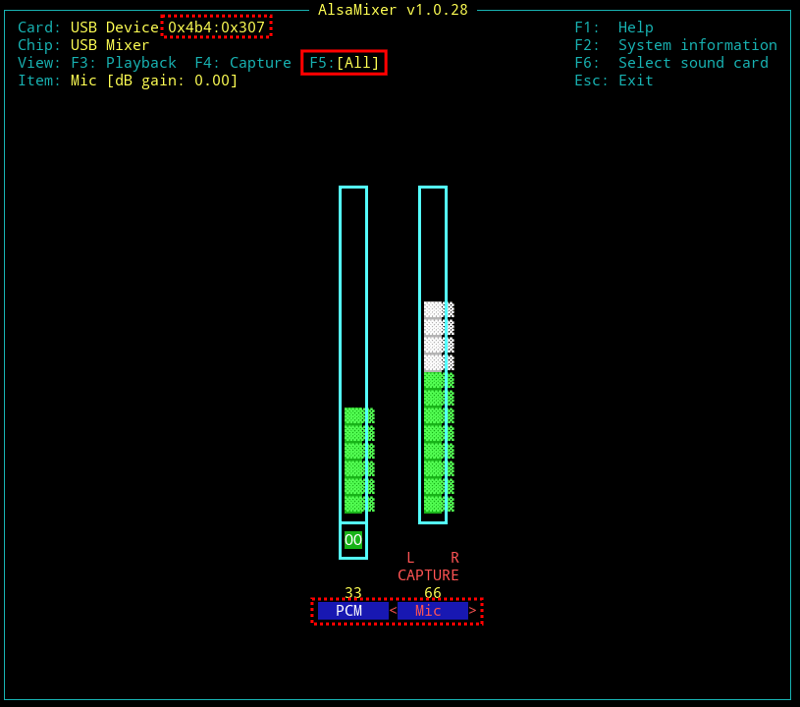
NanoPi NEOをSIP電話機にする 後編 (その1)の後に続きの記事をすぐに出したつもりですっかり忘れ果てていた。
ということで、いまさらだけど続き。
今回はそのLinphoneに付属するLinphonecshを使う。
linphonecsh
$ linphonecsh Usage: linphonecsh[arguments] where action is one of init : spawn a linphonec daemon (first step to make other actions) followed by the arguments sent to linphonec generic : sends a generic command to the running linphonec daemon followed by the generic command surrounded by quotes, for example "call sip:joe@example.net" register : register; arguments are --host --username --password unregister : unregister dial : dial status : can be 'status register', 'status autoanswer' or 'status hook' soundcard : can be 'soundcard capture', 'soundcard playback', 'soundcard ring', followed by an optional number representing the index of the soundcard, in which case the soundcard is set instead of just read. exit : make the linphonec daemon to exit.
利用できるコマンドは多くない。ただし、genericが使える。linphonecのコマンドをgenericの後に指定することでlinphonecでできることの多くが実行できる。
最初にlinphonecsh initを実行するとlinphonecがバックグラウンド(デーモン化?)で動くみたい。linphonecsh exitでバックグラウンドのlinphonecが終了。
$ ps -ax | grep linphonecsh
9876 ? Ssl 0:19 linphonec --pipe -c /dev/null
他プロセス省略
linphonecsh init後のプロセスリストサウンド周りの確認
NanoPi NEO2に繋いだUSBハンドセットのスピーカーで音を出す、そのマイクで音を拾う。
# aplay -l **** List of PLAYBACK Hardware Devices **** card 0: Codec [H3 Audio Codec], device 0: CDC PCM Codec-0 [] Subdevices: 1/1 Subdevice #0: subdevice #0 card 1: U0x4b40x307 [USB Device 0x4b4:0x307], device 0: USB Audio [USB Audio] Subdevices: 1/1 Subdevice #0: subdevice #0
USBのハンドセットはUSB Device 0x4b4:0x307と認識されている。重要なのは赤字の部分。これがデバイスIDで後で使う。この例ではコロンの有無しか違わないけどこれを間違うと思い通りに動かない。
引き続きミキサーでコントロール対象のポート名を見る。ここでamixerを使うとわからなくなってしまうのでalsamixerを使う方が無難。
# alsamixer

alsamixerが起動したときの画面。標準のサウンドデバイスの状態が表示されている筈。
上の画像だとNanoPi NEO2の標準 H3 Audio Codecになっている(画像左上の赤色の破線の四角部分)。つまりNanoPiのオーディオ用ピンヘッダ(購入時未取り付け)にスピーカーを繋いだときに鳴るやつ。
今回はUSBハンドセットを確認するので右上の赤い四角部分、ファンクションキー6番[F6]で表示するサウンドカード(デバイス)を変更する。

サウンドカード(デバイス)のリストが画面中央に表示されるので矢印キー上下でUSBハンドセットのデバイスに合わせて[Enter]。上の画像ではUSB Device 0x4b4:0x307を選んだ。

画像の左上、カード(デバイス)はUSBデバイスになっている。ポート(プロファイル)はおそらく再生用(Playback)だけが表示されている筈なので録音(Capture)も合わせて確認する。[F5]を押すと両方が表示される。
上の画像では再生用はPCM、録音用はMicとなっている。
USBハンドセットで電話するスクリプト
後編 (その1)で使用したスクリプトにちょこっと足しただけ。ブログ記事なので最低限動く程度の簡易版とする。細かいことはしない。
また、エラー処理もかなり手抜き。ただし、ログだけは取るようにした。
本当はSIPサーバへのレジスト状態を確認して必要に応じて再レジストするとかレジストできない場合のエラー処理を入れたかったが、NanoPi NEO2用にインストールしたlinphonecshが悪いのか他の何かが原因なのかlinphonecsh status registerでレジスト状態に関わらず-1を返されることが多いので今回は解決せずに無視することにした。
1 2 3 4 5 6 7 8 9 10 11 12 13 14 15 16 17 18 19 20 21 22 23 24 25 26 27 28 29 30 31 32 33 34 35 36 37 38 39 40 41 42 43 44 45 46 47 48 49 50 51 52 53 54 55 56 57 58 59 60 61 62 63 64 65 66 67 68 69 70 71 72 73 74 75 76 77 78 79 80 81 82 83 84 85 86 87 88 89 90 91 92 93 94 95 96 97 98 99 100 101 102 103 104 105 106 107 108 109 110 111 112 113 114 115 116 117 118 119 120 121 122 123 124 125 126 127 128 129 130 131 132 133 134 135 136 137 138 139 140 141 142 143 144 145 146 147 148 149 150 151 152 153 154 155 156 157 158 159 160 161 162 163 164 165 166 167 168 169 170 171 172 173 174 175 176 177 178 179 180 181 182 183 184 185 186 187 188 189 190 191 192 | #!/usr/bin/python
import re
import time
from datetime import datetime
import subprocess
import struct
from PIL import Image, ImageDraw, ImageFont
keys = {
0x00 : "",
0x03 : "1",
0x09 : "2",
0x0f : "3",
0x04 : "4",
0x0a : "5",
0x10 : "6",
0x05 : "7",
0x0b : "8",
0x11 : "9",
0x06 : "*",
0x0c : "0",
0x12 : "#",
0x02 : "left",
0x0e : "right",
0x01 : "yes",
0x0d : "no",
0x19 : "vol+",
0x1c : "vol-",
0x1b : "mute",
}
hiddev = "/dev/hidraw0" #ハンドセットのデバイス
sndcard = "U0x4b40x307" #aplay -lで表示されるデバイスID
snddev = "PCM" #再生用ポート名
micdev = "Mic" #マイク用ポート名
modmute = False #通話時ミュート初期値(オフ)
spkrvol = 60 #通話時のスピーカー音量(60%)可変
micvol = 50 #通話時のマイク音量(50%)固定
cfrom = "" #通話相手の表示用(空白)
def func_aplog(str):
f = open('./phone.log', 'a')
f.write(datetime.now().strftime("%Y/%m/%d %H:%M:%S ") + str)
f.close()
def func_linphone(cat, cmd, bln):
try:
if bln == 1:
ret = subprocess.check_output(cmd.split())
else:
ret = subprocess.check_output(cmd)
func_aplog(cat + ": " + ret + "\n")
return ret
except subprocess.CalledProcessError as err:
func_aplog(cat + " ERROR:\n")
func_aplog(str(err.returncode) + "\n")
func_aplog(str(err.cmd) + "\n")
func_aplog(err.output + "\n")
return "err"
def func_lgtonoff(bln):
file = open( hiddev, "w+b" );
if bln:
buf = "040f".decode("hex")
else:
buf = "0400".decode("hex")
file.write(buf)
file.flush()
file.close();
cmd = '/usr/bin/linphonecsh init'
func_linphone("INIT", cmd, True)
time.sleep(1)
cmd = '/usr/bin/linphonecsh register --username 6000 --host 192.168.0.100 --password himitsu'
func_linphone("REGIST", cmd, True)
time.sleep(1)
cmd = ['/usr/bin/linphonecsh', 'generic', 'soundcard use 2']
print(func_linphone("STATUS", cmd, False))
subprocess.check_output(['amixer', '-c', sndcard, 'set', snddev, '100%'])
subprocess.check_output(['amixer', '-c', sndcard, 'set', micdev, str(micvol) + '%'])
file = open( hiddev, "w+b" );
def getKey():
buf = file.read(8)
return keys[ord(buf[1])]
def paint():
pixels = img.load() # create the pixel map
pixels = img.transpose(Image.ROTATE_180).load() # create the pixel map
b = [0, 0, 0, 0, 0, 0, 0, 0, 0, 0, 0, 0, 0]
for r in range(0, 8):
for s in range (0, 12):
for i in range (0, 12):
b[i] = 0
for j in range (0, 8):
if (pixels[i + 12 * s, j + 8 * r] < 128):
b[i] |= 2**j
buf="0301".decode("hex")+chr(r)+chr(s*11)+chr(b[0])+chr(b[1])+chr(b[2])+chr(b[3])+chr(b[4])+chr(b[5])+chr(b[6])+chr(b[7])+chr(b[8])+chr(b[9])+chr(b[10])+chr(b[11])
file.write(buf)
file.flush()
def drawText(text):
draw.text((0, 0), drawText.old , 255, font=font)
draw.text((0, 0), text , 0, font=font)
drawText.old = text
paint()
drawText.old = ""
img = Image.new( '1', (144,64), "white")
draw = ImageDraw.Draw(img)
font = ImageFont.truetype("/usr/share/fonts/truetype/dejavu/DejaVuSansMono.ttf", 20)
text = ""
# write canvas to display
paint()
# clear canvas
draw.rectangle((0,0,142,63), fill=255)
while( 1 ):
k = getKey();
if (k == ""):
0
elif (k == "yes"):
reslt = subprocess.check_output(['/usr/bin/linphonecsh', 'generic', 'calls'])
if 'No active call.' not in reslt:
cfrom = re.findall("[\w.-]+@[\w.-]+.\w+", reslt)
drawText(cfrom[0])
elif (k == "no"):
text = ""
drawText(text)
elif (k == "left"):
func_lgtonoff(True)
reslt = subprocess.check_output(['/usr/bin/linphonecsh', 'generic', 'calls'])
if 'IncomingReceived' in reslt:
text = ""
subprocess.check_output(['amixer', '-c', sndcard, 'set', snddev, '50%'])
cmd = ["/usr/bin/linphonecsh", "generic", "answer"]
func_linphone("ANSWER", cmd, False)
drawText("Answer")
elif 'No active call.' in reslt:
if len(text) > 2:
cmd = ['/usr/bin/linphonecsh', 'dial', text]
drawText('DIAL' + text)
func_linphone("DIAL", cmd, False)
text = ""
elif (k == "right"):
text = "Terminate"
drawText(text)
cmd = ['/usr/bin/linphonecsh', 'generic', 'terminate']
func_linphone("STATUS", cmd, False)
time.sleep(1)
text = ""
drawText(text)
func_lgtonoff(False)
subprocess.check_output(['amixer', '-c', sndcard, 'set', snddev, '100%'])
elif (k == "vol+"):
spkrvol += 10
if spkrvol > 100:
spkrvol = 100
subprocess.check_output(['amixer', '-c', sndcard, 'set', snddev, str(spkrvol) + '%'])
drawText("Vol:" + str(spkrvol) + "%")
elif (k == "vol-"):
spkrvol -= 10
if spkrvol < 10:
spkrvol = 10
subprocess.check_output(['amixer', '-c', sndcard, 'set', snddev, 0])
drawText("Vol:" + str(spkrvol) + "%")
elif (k == "mute"):
if modmute:
cmd = ['/usr/bin/linphonecsh', 'generic', 'unmute']
func_linphone("MUTE_OFF", cmd, False)
modmute = False
drawText("Mute Off")
else:
cmd = ['/usr/bin/linphonecsh', 'generic', 'mute']
func_linphone("MUTE_ON", cmd, False)
modmute = True
drawText("Mute On")
else:
text = text + k
drawText(text)
file.close();
|

①はスクリプトでleftのボタン。RING鳴動時の着信用と宛先番号入力後の発信用として使う。
④はスクリプトでrightのボタン。通話終了やダイヤル入力のリセットに使う。
⑤はスクリプトでyesのボタン。通話中に相手の番号をハンドセットの液晶に表示する。
⑦はスクリプトでnoのボタン。液晶の文字を消す(だけ)。
②③⑥は使わない。
Vol+は通話時のスピーカーの音量を10%上げる。(最大100%)
Vol+は通話時のスピーカーの音量を10%下げる。(最小10%)
muteは通話時にハンドセットのマイクをオフにする。もう一度押すとオン。(トグル)
液晶のバックライトは①(left)を押すと点灯。③(right)を押すと1秒後に消灯、ただそれだけ。相手が通話を終了させた場合でも手動で③(right)を押さないとバックライトは消灯しない。
また、発進時に相手の番号を入力してから①(left)を押すと番号入力時はバックライト消灯なので、①(left)を押して番号入力して再度①(left)を行うとバックイト点灯で番号を入力できる。番号入力中に放置してもずっとその状態なので③(right)でリセットする必要がある。
手抜きなので携帯などとは少し勝手が違うけど必要最小限のことはできる。着信時のRINGは音量100%固定のつもり。マイクの音量も50%で固定。上のスクリプトではボタン操作では変更できないのでスクリプトを変更して調整。
たぶん、こんなん気に入らねぇと思うだろうから好みに改造すれば良いかと。
Pythonは殆ど使ったことがないので文法間違ってたらスンマセン。
後編 (その1)と今回利用したCheap USB Skype/VoIP phone protocol discoveryのスクリプトの作者に感謝。これとlinphonecshのおかげで凄い簡単に電話機能を実現できた。
関連記事:- アッチッチなNanoPi NEO3を冷やしたい パッド交換
- NanoPi NEO3冷却力強化後のUnixBench
- アッチッチなNanoPi NEO3を冷やしたい
- NTPサーバの時刻ソースに対するズレの調整
- NanoPi NEO3をv6プラスのルーターにする systemd-networkd + nftables
- NanoPi NEO3のUSB3.0ポートのネットワーク速度
- NanoPi NEO3でArmbian よきところでUnixBench
- NanoPi NEO3が届いた
- NanoPi NEOにRTCモジュールを付ける
- 新しい中華GPSモジュールとChronyで作るNTPサーバ (中編)
- 新しい中華GPSモジュールとChronyで作るNTPサーバ (前編)
- Prometheus2とGrafana6によるシステム監視 シングルボードコンピュータの温度表示
- NanoPi NEOでNTPサーバ再構築 (全まとめ)
- 新しいIP電話機を安く買いたい Grandstream
- 新しいIP電話機を安く買いたい Fanvilの残り
- 新しいIP電話機を安く買いたい
- NanoPi NEO2をv6プラスのルーターにする 後編
- NanoPi NEO2をv6プラスのルーターにする 前編
- ELK Stackでシステム監視 FilebeatでNTP統計ログ取得 Logstashで加工
- NanoPi NEO2(arm64)用にFilebeatをビルド
- NanoPi NEO2を超コンパクトなアルミケースに入れる
- NanoPi NEO2用armbian 5.41 Debian 9 Stretch next 4.14.18
- NanoPi NEO2を100均の灰皿に入れてみた
- NanoPi NEO2のシステム監視 RPi-Monitorとnetdata
- Cisco 7961G電話機でCardDAVの連絡帳を利用する
- Cisco 7961G電話機にSSHでログインする
- Cisco 7961G電話機にツイッターを表示する
- Cisco 7961G電話機のサービスメニュー設定
- Cisco 7961G電話機の日本語化と背景画像
- NanoPi NEOとGPSモジュール用アルミケースを作る